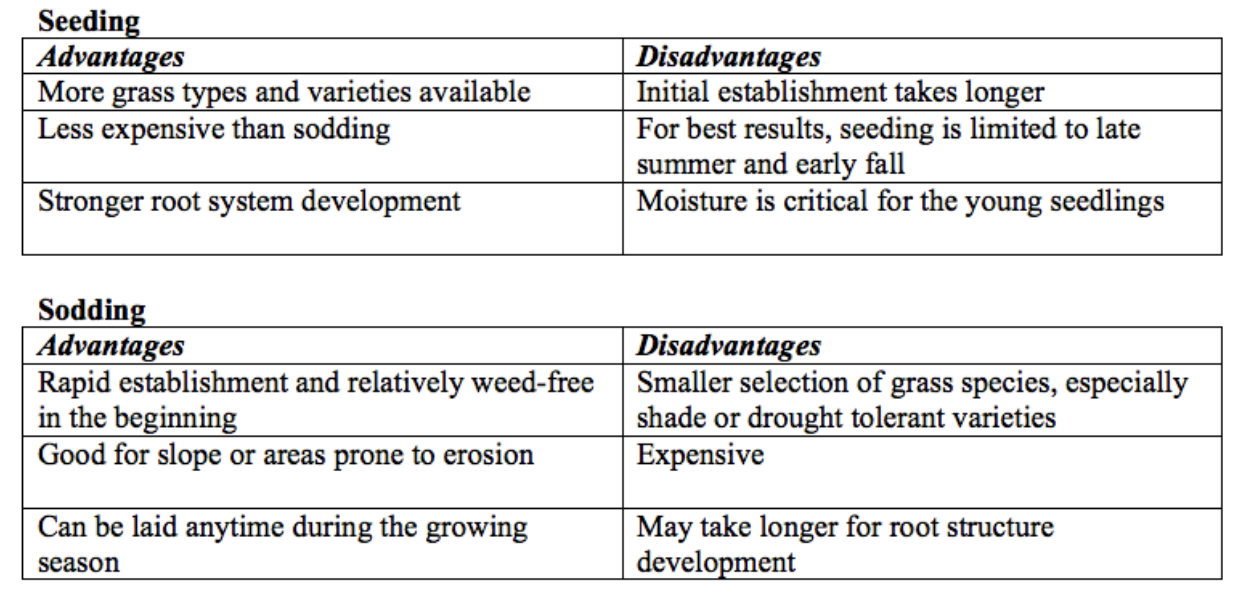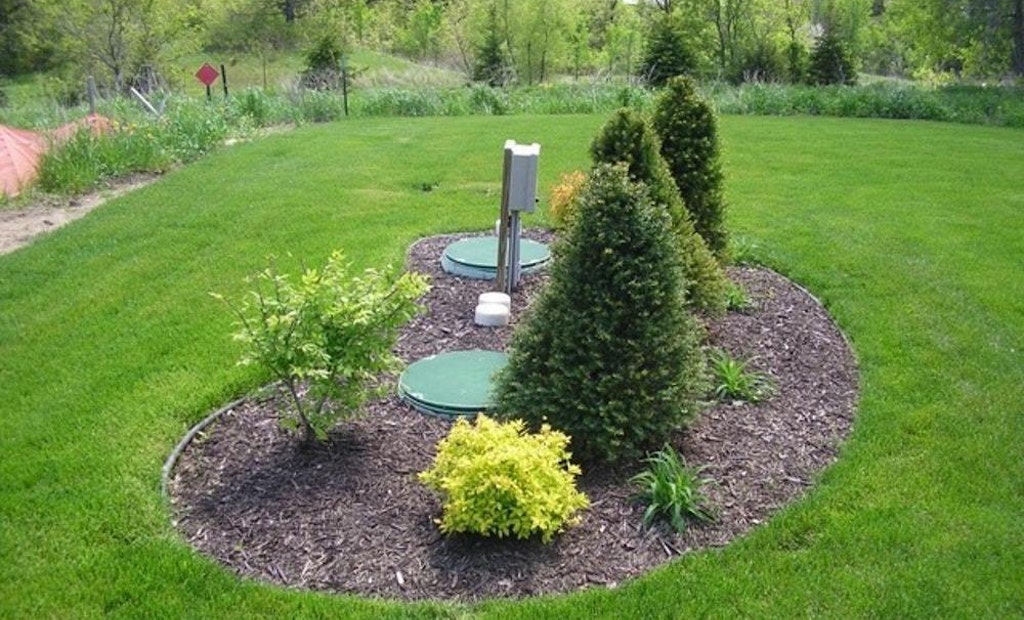Interested in Onsite Systems?
Get Onsite Systems articles, news and videos right in your inbox! Sign up now.
Onsite Systems + Get AlertsTo ensure a properly functioning soil-based septic system, a suitable vegetative cover must be established. Proper plantings on soil treatment systems will minimize negative impacts and promote positive outcomes. The right vegetative cover helps keep the soil in place which prevents erosion, helps the septic system function optimally by removing moisture and nutrients from the soil treatment area, provides an insulating layer when needed, and makes the area more attractive.
Soil cover
The type of soil over a soil treatment area (STA) is critical to achieving the establishment of appropriate vegetation. In general, the cover material needs to allow air and oxygen to get into the system and should not be compacted during installation or landscaping. The soil cover should be sloped to shed rainfall and support the growth of vegetation. Property owners should not add soil cover over their system without consulting the designer, installer or permitting authority. Homeowners should not put down plastic sheeting over the STA as air/oxygen transfer into the system is critical.
What not to plant over the over the STA
Soil treatment areas include trenches, beds, mounds, at-grades, drip irrigation/distribution and spray irrigation. Do not place trees or shrubs on the septic system; roots may invade the piping and cause damage. Water-seeking trees such as poplar, birch, beech, walnut, maple, willow, linden and elm should be planted at least 50 feet from the STA. The rule of thumb is to keep a distance equal to the anticipated height of the tree at its maturity, plus 20%. Thus, a tree 30 feet tall at maturity should be kept 36 feet away.
In general, it's advisable to choose smaller ornamental trees such as cedars, cherry, crabapples, dogwoods, cotinus, cercis, snowbell, acer palmatum, acer grisem and acer amur. Many properties may have existing trees that are closer to the septic system than these recommendations. During construction of the septic system the tree root structure should be protected from compaction, typically with a temporary fence. If the trees are influenced by the water from the septic system this may also stress the trees due to the increase in moisture, which is not positive for many varieties.
Any woody perennial including bamboo, vines (wisteria, bittersweet, morning glory, campsis and hops), shrubs (low, woody perennial plants 3-15 feet in height) should not be planted on top of the STA, but can be planted with caution within 5-10 feet of the edge of the system. Vegetable gardens should not be planted in the STA as disturbing the soil with these annual crops is not good for the septic system and most vegetable gardens need frequent irrigation.
What to plant over the STA
In general, herbaceous plants such as turf grasses, wildflowers, and native grasses are the best cover for septic systems. Recommendations include drought-tolerant plants with short, fibrous root systems chosen for hardiness in your climate and in sun and shade conditions as required. Turf grasses have root systems that hold soil in place, require maintenance like a lawn, and are available in a variety of mixes designed to suit the site conditions. Wildflowers and native grasses are an attractive alternative to turf grass while providing many of the same benefits including fibrous roots, low maintenance (once established), and tolerance of dry soil conditions. Match the plant’s sun requirements and USDA Plant Zone to the site before planting. When planting perennials, space the plants close to each other to control erosion, suppress weeds, and get an adequate survey as soon as possible.
Planting grass
There are two primary methods of establishing a new lawn: seeding and sodding. Erosion control is important when establishing vegetative cover. An erosion control blanket should be laid down after the seeds have been distributed (this will help retain moisture and protect the seeds and soil.) Another product available in landscape supply stores is an erosion control blanket with grass seeds attached. This product makes protecting and seeding a one-step process. The following are advantages and disadvantages to seeding and sodding.

Plant establishment
Until the vegetation is established the soil needs to be protected with either an erosion control blanket or mulch such as straw, hay or leaves. If perennials are being planted, it can take up to two years to have the area covered. If a system is being installed in the late fall, an erosion control blanket or mulch should be applied to help protect the topsoil as well as to insulate the system in cold climates. Erosion control blankets are often composed of straw or coconut fiber layers between two jute mesh layers. The blanket is staked in place, covering the entire surface, and holes are cut through the layers to create openings for the plants. The blanket is biodegradable, so it does not need to be removed. This material can be purchased at landscape supply stores. The area should be reseeded if there is no seed germination after four weeks. While the vegetative cover is getting started, the area will need to be weeded to help the desired plants out-compete the weeds.
Irrigation and fertilizer
If the correct vegetation is planted, watering is only necessary within the first few weeks after seeding, sodding or planting. Once the vegetation is established, it needs to be watered only when the vegetation shows extreme signs of stress. STA areas take thousands of extra gallons of water per day than the soil previously infiltrated and the added stress of excessive watering or irrigation could stress the septic system. All surface drainage should be directed away from septic system components. Fertilizing over the STA is not advisable as human wastewater contains significant amounts of nitrogen and phosphorous and fertilizing may cause over-accumulation or leaching.
Mowing and maintenance
Regular mowing with a sharp mower blade at the proper height will help keep grass growing vigorously and maintain adequate density to completely cover the soil surface. This will cut down on the amount of water lost from the grass, thereby conserving moisture, and reducing the need for additional watering. The general rule of thumb for mowing grass is to mow high, mow frequently, and allow the clippings to return to the lawn. With native vegetation on the soil treatment area it is critical that weeding of invasive or woody vegetation occur on an annual basis and that burrowing animals are controlled.
About the author
Sara Heger, Ph.D., is a researcher and educator in the Onsite Sewage Treatment Program in the Water Resources Center at the University of Minnesota, where she also earned her degrees in agricultural and biosystems engineering and water resource science. She presents at many local and national training events regarding the design, installation and management of septic systems and related research. Heger is the President-Elect of the National Onsite Wastewater Recycling Association and she serves on the NSF International Committee on Wastewater Treatment Systems. Ask Heger questions about septic system design, installation, maintenance and operation by sending an email to kim.peterson@colepublishing.com.






